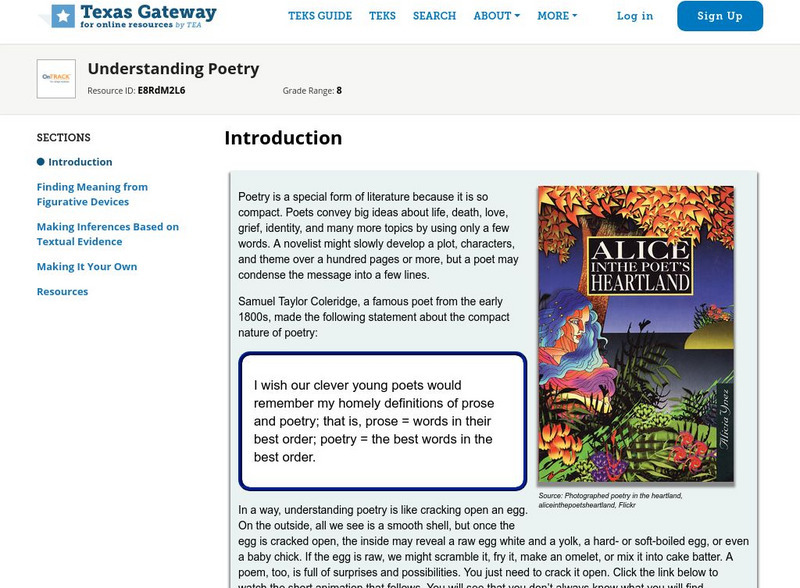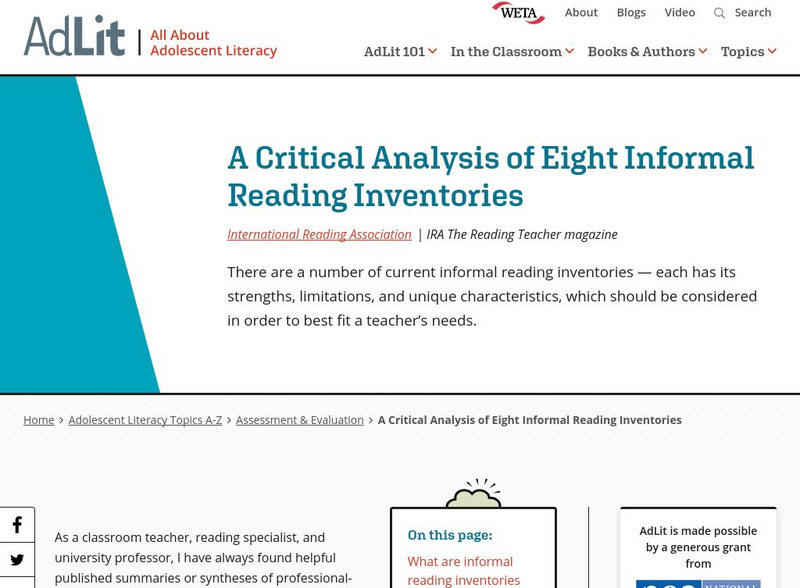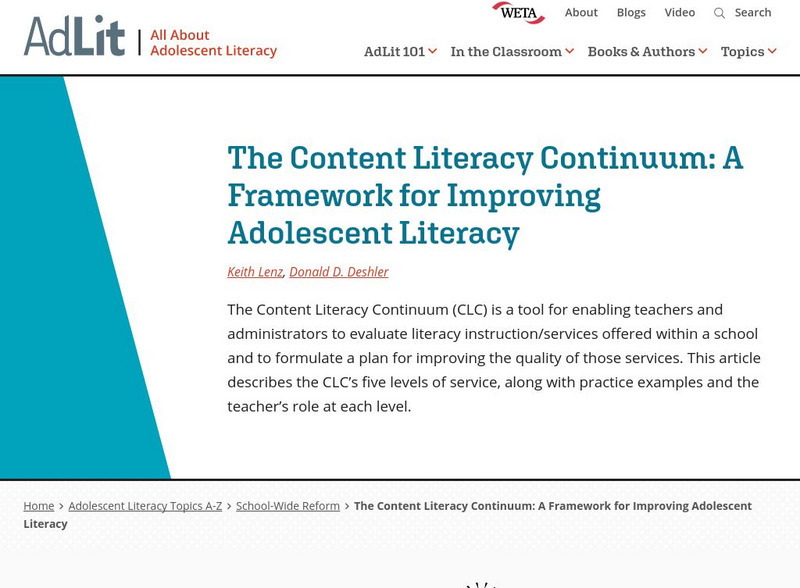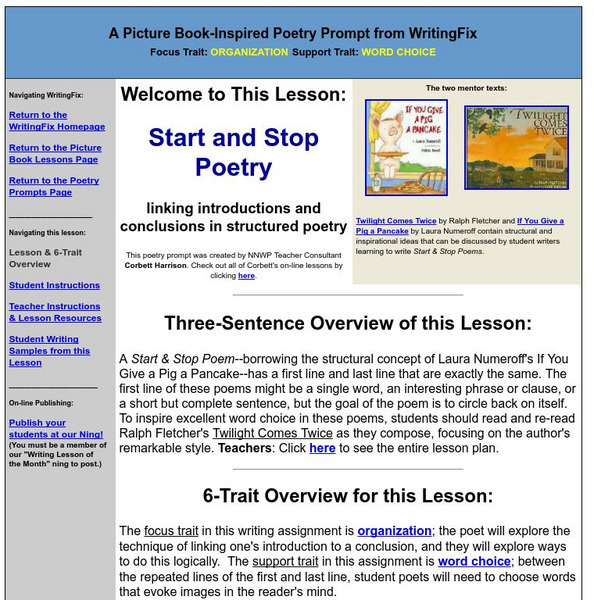Sophia Learning
Sophia: Reading Comprehension and Classroom Discussions
This tutorial focuses on active reading comprehension strategies including reading aloud, taking notes, summarizing, and writing in the margins of books to improve retention and class discussion. It includes two Flickr videos on active...
Texas Education Agency
Texas Gateway: Understanding Poetry
[Accessible by TX Educators. Free Registration/Login Required] Students learn to understand and explore different types of poetry.
Texas Education Agency
Texas Gateway: Understanding Poetry (English 7 Reading)
You will learn the importance of graphical elements (e.g., capital letters, line length, word position) in the meaning of a poem.
CommonLit
Common Lit: What Happened Here
CommonLit.org is a wonderful resource to use in a Language Arts classroom. Each text is accompanied by guided reading questions, assessment questions, and discussion questions. In addition, students can click on words to see the...
Texas Education Agency
Texas Gateway: Understanding Poetry
A learning module that teaches students how to understand poetry in four mini lessons: Introduction, Finding Meaning from Figurative Devices, Making Inferences Based on Textual Evidence, and Making It Your Own.
Library of Congress
Loc: Found Poetry With Primary Sources: The Great Depression
Students explore poetry using American Life Histories: Manuscripts from the Federal Writers' Project, 1936-1940 collection of American Memory, which covers personal stories collected by the Works Progress Administration. In particular,...
Library of Congress
Loc: Poetry 180: Entrance
In this poem, the reader is encouraged to take the chance of entering into a room of the unknown.
Library of Congress
Loc: Poetry 180: How to Listen
In this non-prose piece, the poet shares how to listen carefully to others.
AdLit
Ad lit.org: The Enhanced Reading Opportunities Study
While much has been learned about literacy in the elementary grades, less is known about programmatic approaches that help struggling adolescent readers acquire the skills they need to succeed in high school. The Enhanced Reading...
AdLit
Ad lit.org: Teach the Seven Strategies of Highly Effective Readers
To improve students' reading comprehension, teachers should introduce the seven cognitive strategies of effective readers: activating, inferring, monitoring-clarifying, questioning, searching-selecting, summarizing, and...
AdLit
Ad lit.org: Seven Strategies to Teach Students Text Comprehension
Comprehension strategies are conscious plans - sets of steps that good readers use to make sense of text. Comprehension strategy instruction helps students become purposeful, active readers who are in control of their own reading...
AdLit
Ad lit.org: Literacy Practices Interview
Literacy practices interviews are informal assessments that elicit information on students' reading and writing activities, including their free-time reading habits, their access to books, and their attitudes toward reading and writing....
AdLit
Ad lit.org: A Critical Analysis of Eight Informal Reading Inventories
There are a number of current informal reading inventories - each has its strengths, limitations, and unique characteristics, which should be considered in order to best fit a teacher's needs.
AdLit
Ad lit.org: For Middle Schoolers: Activities to Build College Level Reading Skills
ACT has developed this list of activities to help middle-school students improve their reading ability. Parents and educators can use this information to help ensure that these students are on target for college and career readiness.
AdLit
Ad lit.org: Key Literacy Component: Text Comprehension
Text comprehension allows readers to extract or construct meaning from the written word. Students who misread words or misinterpret their meanings are at a disadvantage. Proper instruction can boost students' skills in this key area.
AdLit
Ad lit.org: The Content Literacy Continuum: Improving Adolescent Literacy
The Content Literacy Continuum (CLC) is a tool for enabling teachers and administrators to evaluate literacy instruction/services offered within a school and to formulate a plan for improving the quality of those services. This article...
AdLit
Ad lit.org: Key Literacy Component: Fluency
Fluent readers can read text accurately, smoothly, and with good comprehension. Students who get bogged down in the mechanics of reading have trouble with this skill. With proper instruction, struggling readers can improve their fluency.
AdLit
Ad lit.org: Effective Reading Interventions for Kids With Learning Disabilities
Research-based information and advice for sizing up reading programs and finding the right one for your child with a learning disability.
AdLit
Ad lit.org: Assistive Technology Tools: Reading
Learn about assistive technology tools - from audiobooks to variable-speed tape recorders - that help students with reading.
Writing Fix
Writing Fix: Start and Stop Poetry
In this instructional activity students will analyze the cyclical patterns within poetry.
abcteach
Abcteach: Middle/high School Reading Comprehension
[Free Registration/Login Required] Here one can generate several reading comprehension activities for middle or high school students with material ranging from biographies to non-fictional content.
Vocabulary.com
Some Helpful Poetry Terms
This site contains a list of 24 poetry terms. Teachers can digitally assign this list to their students to reinforce the spellings, pronunciations, and meanings of these words
Wisconsin Response to Intervention Center
Wisconsin Rt I Center: Close Reading [Pdf]
Teachers will learn about the importance of close reading. Teachers will learn how to implement close reading; measure progress of close reading; and find research to support close reading. A list of close reading activities are also...
Polk Brothers Foundation Center for Urban Education at DePaul University
Depaul University: Center for Urban Education: Lecto Fluido [Pdf]
This fluency graphic organizer for reading speed and comprehension will be used to record reading times and what they learned. Guiding questions are included to help students reflect about what they learned. This resource's prompts are...






















